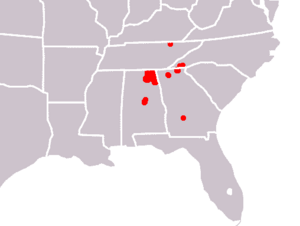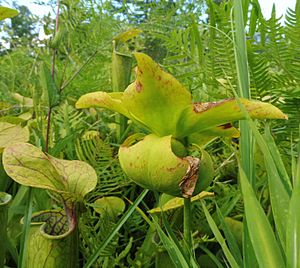Green pitcher plant facts for kids
Quick facts for kids Green pitcher plant |
|
|---|---|
 |
|
| Conservation status | |
| Scientific classification | |
| Genus: |
Sarracenia
|
| Species: |
oreophila
|
 |
|
| Sarracenia oreophila range | |
| Synonyms | |
|
|
The Sarracenia oreophila, also known as the green pitcherplant, is a special carnivorous plant. This means it eats insects! It belongs to the Sarracenia group of plants.
This plant has unique leaves shaped like tubes or pitchers. These pitchers act like clever traps for insects. The narrow pitcher leaves can grow up to 75 centimetres (30 in) tall from the ground. Their opening, or mouth, is about 6 to 10 centimetres (2.4 to 3.9 in) around. Like all Sarracenia plants, it naturally grows in North America. The green pitcherplant is the most endangered Sarracenia species. It only grows in a few places in northern Alabama, North Carolina, Georgia, and used to grow in Tennessee.
Contents
Where Does its Name Come From?
The name Sarracenia oreophila tells us where this plant likes to live. The first part, Sarracenia, comes from Michel Sarrazin. He was a French-Canadian scientist who first described this type of plant.
The second part, oreophila, means "mountain-loving." This word comes from Greek words. Oros means "mountain," and philos means "loving." This name fits because the plant grows in the mountainous regions.
How it Catches Food
Just like other Sarracenia plants, the green pitcherplant catches insects using its special leaves. These leaves are rolled into tubes. At the bottom of the tube, there's a pool of liquid that helps digest the insects.
The pitcher tube of this plant is similar to another type, Sarracenia flava. However, the green pitcherplant has a wider opening and neck. It's also usually a bit shorter, growing up to about 60 cm (24 in).
The top part of the leaf forms a lid, called an operculum. This lid helps stop too much rain from getting into the pitcher. If too much rain got in, it would dilute the digestive liquids.
The upper inside of the pitcher has short, stiff hairs that point downwards. These hairs guide insects towards the opening of the tube. The opening itself has a 'nectar roll' or peristome. This part is covered in glands that make sweet nectar. This nectar attracts insects.
When insects land inside the tube, they find it very slippery. This is because of a smooth, waxy coating on the upper walls. Insects often lose their footing and fall to the bottom. Once at the bottom, the digestive fluid, special wetting agents, and inward-pointing hairs make it very hard for them to escape. Some large insects, like wasps, have been known to chew their way out sometimes!
The pitchers can look different. Some are all green, while others have light or heavy red veins. As the traps get older, they can also turn a pink or red color.
Beautiful Flowers
In spring, the green pitcherplant grows large, yellow flowers. These flowers have a 5-part shape. The yellow petals are long and hang down over the flower's umbrella-like center. This center is held upside down on a long stalk, about 50 cm (20 in) tall.
The parts of the flower that receive pollen, called the stigma, are at the tips of this umbrella shape. Insects that help pollinate the plant usually enter the flower from above. They push their way into the space between the petals and the umbrella. As they enter, they leave any pollen they are carrying on the stigmas. To leave, the insects usually lift a petal. This clever one-way system helps make sure the plant gets cross pollination from other plants.
Life Cycle of the Green Pitcher Plant
In late summer and autumn, the green pitcherplant stops making its carnivorous pitcher leaves. Instead, it grows flat, non-carnivorous leaves called phyllodia. For this plant, these leaves are short, curved, and shaped like a sickle.
The natural places where this plant lives often dry out quickly in July. These smaller phyllodia probably need less water than the spring pitchers. This is a special way the plant has adapted to its environment. Even if these plants are kept wet in gardens, they still lose their pitchers in mid-summer. Also, the plant flowers and grows pitchers at the same time at the start of the season. This is because drier conditions later on would prevent new pitchers from growing after the flowers.
Why it's in Danger
The green pitcherplant has faced a huge decline in numbers. Many of its natural homes, which are special wet bog areas, have been changed or destroyed. This happens because of new buildings, farms, and other developments.
Pitcher plants have also been collected too much by people for sale. These rare and unusual plants are very popular with collectors. Today, only about 34 natural groups of these plants are left. These groups are small and spread out, with most having fewer than 50 individual plants.
Protecting This Special Plant
The green pitcherplant is listed as Endangered under the United States Endangered Species Act. There's a plan to help it recover. This plan mainly focuses on protecting the groups of plants that still exist. The biggest threat to the green pitcherplant is still too much collection.
Collecting these plants is against the law in the United States. The species is also listed on Appendix I of the Convention on International Trade in Endangered Species (CITES). This means that selling wild-sourced plants (or parts of them) across countries for money is not allowed. Non-commercial trade is strictly controlled.
Efforts are also being made to grow plants outside their natural habitat. Seeds are stored at the USDA National Seed Technology Laboratory in Fort Collins. The Atlanta Botanical Garden is growing new plants from seeds. These plants might be put back into the wild in the future.
See also
 In Spanish: Jarra verde para niños
In Spanish: Jarra verde para niños





